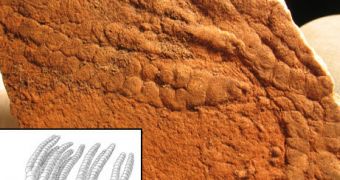The phrase "sex is one of the oldest professions" has got a scientific proof. A recent research published in the journal "Science" describes the oldest known animal "caught in the act." This ancient sexual encounter occurred amongst 565-Ma-old tubular invertebrates called Funisia dorothea. Funisia fossils were found in 2005 on an ancient seafloor in South Australia. The 0.3 m (1 ft) tall ropelike animals were tightly packed into groups of the same age and looked like sponges or corals.
Sponges and corals breed by releasing floating eggs and sperm, resulting a great number of offspring, called larval spatfalls. The researchers say the fact that the Funisia fossils had all the same body position shows they reproduced like corals. Sex evolved before the origin of animals, but Funisia is one of the oldest known animals for which there is evidence of sexual reproduction.
"We can't say 'definitely' about something that happened 565 million years ago. But it's very likely that this was sexual reproduction," said co-author Mary Droser, professor of earth sciences at the University of California, Riverside.
Funisia are comprised into the Ediacaran biota, the first ecosystems made of multicellular life-forms evolved beyond bacteria, protozoa and mono-cellular algae. Ediacaran fauna, known since the '60s, thrived from 580 Ma ago until 540 Ma ago, when the Cambrian Explosion produced most lineages of living animals.
Not everybody is convinced that this is proof of Funisia sex. "Researchers still can't be certain whether the ancient organisms were truly animals, how they reproduced, or when sex first arose within the line leading to modern animals. I would say that the case for this being evidence for the 'first-ever example of animal sex' is weak," said Bruce Runnegar, a paleontologist at the University of California, Los Angeles.
The researchers also found evidence that Funisia employed also an asexual reproduction type, budding, common in modern sponges, cnidaria (corals and hydras) and yeast.
"It means that some complex survival strategies still in use by today's invertebrates were used in truly ancient times. [Different reproductive techniques] are not just evolutionary adaptations to threats such as predators and competition for food resources. It's sort of amazing that these earliest animals on the planet were rather complex, and that Earth's first ecosystems had rather complex ecologies," said Droser.

 14 DAY TRIAL //
14 DAY TRIAL //